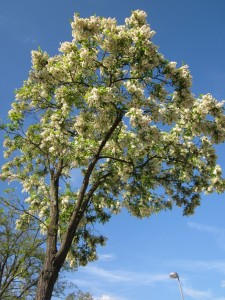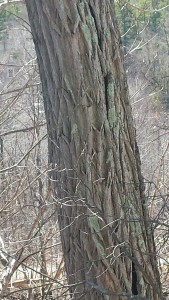

Deeply furrowed grey bark with rust color in furrows
Compound leaves with oval-shaped leaflets
Skeins of white or purple pea-like flowers
Thorns on young shoots and small branches
Fast-growing, slender trees that like full sun
Often springs up from existing locust roots or stumps
If you live in the eastern US, then you’ve seen black locust. As noted elsewhere, it is native to the Appalachian mountain region, but has been transplanted to almost every corner of the continental US, and has been taken to other parts of the world as well.
Black locust has compound leaves, meaning that each “leaf” on the tree looks like a miniature branch, with small leaflets along its length. These compound leaves are arranged alternately along the branches of the tree.
Flowers appear for a brief period in late spring to early summer and explode all over a healthy tree, weighing down the branches, causing honey bees to swarm over them and creating a strong, lovely scent that you have likely noticed, but may not have associated with locust trees. Look for locust in bloom, get close and smell it. The flowers are edible, by the way.
The flowers provide a tip that this tree is a relative of the pea family, and is a legume, so it helps fixate nitrogen into the soil. It is a great tree for reforestation, is drought resistant and tolerates a broad range of soil types.
Black locust is considered an invasive species in some areas, even a “weed,” although this is perhaps a reflection of not appreciating the value of black locust. The tree will become established quickly in abandoned fields with good sun, and a nearby locust will tend to launch new trees in your garden beds, so think before you plant.
And if you have mature locust trees that you don’t want, smart tree people are beginning to understand the value of black locust, and will happily take them down for you. If you are in or near New Hampshire and you want your locust trees removed, contact Sharpbuzzworks!
Think before you cut
I make my living turning logs into lumber, but I think some trees should be left alone. Please don’t cut trees without considering their value right where they are.
Black locust is a favorite of honey bees. If you are a beekeeper or there are hives nearby, consider keeping at least some of your black locust trees for these wonderful and endangered insects. I am a beekeeper as well as a sawyer, and our bees need all the help they can get. Locust trees begin to bloom at 2-3 years old, so consider leaving some of those shoots, or move them to a better location.
Very large trees of almost any species should be cut only after careful consideration. Large trees are ecosystems unto themselves, and taking them down destroys habitat and food sources for wildlife. This can be anything from homes for the local birds and animals you love to the massive amount of carbon removed from our air by large trees. So cut if you need to, but think first.